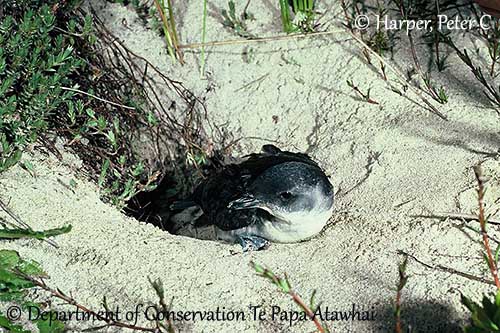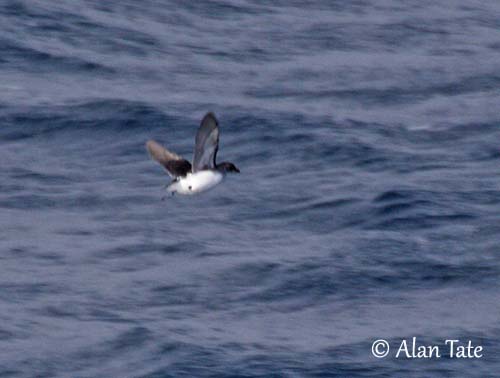
Fr: Puffinure de Géorgie du Sud
Ang: South Georgia Diving-Petrel
All: Breitschnabel-Lummensturmvogel
Esp: Potoyunco de Georgia del Sur
Ita: Petrello tuffatore georgiano
Nd: Zuid-Georgisch Alkstormvogeltje
Sd: Brednäbbad dykpetrell
Photographers:
Alan & Ann Tate
AA Bird Photography
Peter C. Harper
Image © Department of Conservation. Courtesy of Department of ConservationTe Papa Atawhai
Department of Conservation
Title: South Georgian diving petrel
Photographer: Harper, Peter C
Date: 1978
Description: South Georgian diving petrel at burrow entrance, Codfish Island, November 1978
Text by Nicole Bouglouan
Sources:
HANDBOOK OF THE BIRDS OF THE WORLD vol 1 by Josep del Hoyo-Andrew Elliot-Jordi Sargatal - Lynx Edicions - ISBN: 8487334105
A Complete Guide to Antarctic Wildlife by Hadoram Shirihai and Illustrated by Brett Jarrett - Edited by Guy M. Kirwan - ALUL.A Press Oy, Finland - ISBN 9519894705
Wikipedia, the free encyclopaedia
Department of Sustainability, Environment, Water, Population and Communities
South Georgia Diving-Petrel
Pelecanoides georgicus
Procellariiformes Order – Pelecanoididae Family
INTRODUCTION:
The South Georgia Diving-Petrel is a small, stocky bird with short neck, wings and tail, very well adapted to the aquatic life. The short, strong wings allow efficient propulsion underwater, but also in the air and through the waves. In front of an unusually high wave, the bird does not hesitate to fly straight into it and emerges on the other side with similar speed and direction.
The South Georgia Diving-Petrel resembles the other species of genus Pelecanoides, but it has shorter, broader bill. However, it is very similar to the Common Diving-Petrel.
This species has circumpolar range in Southern Oceans.
DESCRIPTION OF THE BIRD:
Biometrics:
Length: 18-21 cm
Wingspan: 32 cm
Weight: 90-150 g
The South Georgia Diving-Petrel adult is a small, plump, black-and-white seabird.
The upperparts are grey-black (blacker in fresh plumage), including upperwing and uppertail. The rump feathers have white bases, and the central row of scapulars often shows whitish tips forming a line often invisible in worn plumage. The secondaries have white tips, forming a trailing edge. The tail is sometimes forked and shows narrow whitish tips in fresh plumage.
On the underparts, the underwing may vary from grey to white, but most are whiter, less tinged greyish, with whiter underwing-coverts, bases and inner webs of the flight-feathers. Body sides, breast, belly and undertail-coverts are white.
On the blackish head, we can see grey feathering behind the eye, extending over most of ear-coverts. Anterior lores, supercilium and neck sides are dark grey to grey, and this patch on the neck sides forms a partial collar. Chin and throat are white.
The bill is blackish-grey, mostly greyer at sides. The base of lower mandible is pale blue-grey. The eyes are dark brown. Legs and webbed feet are pale blue with blackish webs and soles.
Male and female are similar, although the female is larger than male except the tail.
The juvenile resembles adult but it has weaker bill.

RANGE:
The South Georgia Diving-Petrel occurs in Southern Ocean and breeds on several subantarctic islands including South Georgia, Marion, Crozet, Kerguelen, Heard, Auckland and possibly Macquarie.
HABITAT:
The South Georgia Diving-Petrel usually remains in the vicinity of the breeding islands, rarely north to SE Australia. It occurs in cool waters.
It breeds on islands in scree or volcanic ash above the tree line, but also under sand dunes where the ground is flatter.
CALLS AND SONGS: SOUNDS BY XENO-CANTO
The South Georgia Diving-Petrel gives plaintive mewing, different from those of other diving-petrels. At colonies, it produces series of squeaked call-notes, also given in flight. Male and female calls are separable. However, they are usually silent at sea.
BEHAVIOUR IN THE WILD:
The South Georgia Diving-Petrel feeds on cephalopods, planktonic crustaceans such as krill of genus Euphausia, and small fish, copepods and amphipods. The krill is the major part of its diet, and the chick is fed with euphausiids too.
The breeding birds forage about 28-37 km around South Georgia, and less than 100 km from Crozet Islands.
The preys are caught by pursuit-diving underwater. The bird dives from the surface, and it may reach up to 50 metres depth. Surface-seizing is common too. It feeds mostly by day.
Underwater, the South Georgia Diving-Petrel uses its short wings as flippers, while webbed feet and tail are used as rudders. It can cover fair distances below the surface and at great depths. The bird seems to fly underwater!
Unlike other petrels, all the flight-feathers are moulted simultaneously and the bird is flightless for a few weeks. However, without the remiges, the wings of the South Georgia Diving-Petrel are very similar to penguin flippers, and the bird may propel itself very well underwater, that enhances its feeding behaviour.
Like most petrels, the South Georgia Diving-Petrel is active at night at colonies. In order to avoid predation, it flies in directly and lands close to the burrow.
After returning to the colonies, the females perform a pre-laying exodus of 5-15 days. They are colonial nesters. The colonies are often situated well inland and on high ground, involving considerable effort for the adults bringing food to the chick in the burrow because they are very clumsy on land. However, this situation in barren, inhospitable areas where other species cannot survive has reduced the predation.
The South Georgia Diving-Petrel is suspected to be sedentary as it remains in the vicinity of its breeding grounds all year round. It can be seen near convergence zones and at the edge of the continental shelf. Some birds have been recorded between Cape Horn and Antarctic Peninsula, and the species is vagrant to SE Australia and Falklands.
The South Georgia Diving-Petrel has direct flight with fast whirring wingbeats. The take-off requires a long run into the wind on water surface, and when landing, the bird often plunges directly into the sea.

REPRODUCTION OF THIS SPECIES:
The breeding season varies depending on the range, but occurs between September/October and February on Crozet Islands.
The South Georgia Diving-Petrel breeds in colonies established on flat or sloping ground with sparse vegetation, or among grass hummocks. The burrow is dug in soft soil by the birds themselves. It may reach 80-100 centimetres long in average, and the nest-chamber is at the end. It is usually unlined.
The colonies may include 8-300 burrows/100m².
After the pre-laying exodus, the female lays a single white egg. Both adults incubate during 47-50 days in shifts of 2-4 days. The downy chick is sooty-grey. It is brooded for one week and fed by both parents at night. It fledges between 43 and 60 days after hatching, but usually at 45-50 days of age.
This species produces a single brood per season.
PROTECTION / THREATS / STATUS:
The South Georgia Diving-Petrel is affected by predation and human disturbance at colonies. Predators such as cats, rats, skuas and Weka take eggs, chicks and adults on some islands. Cattle and sheep sometimes trample the burrows, like humans walking within the breeding colonies.
The global population is estimated to number around 15,000,000 individuals, and is suspected to decline due to the previous threats.
But currently, the South Georgia Diving-Petrel is evaluated as Least Concern.